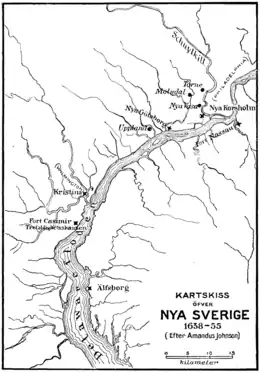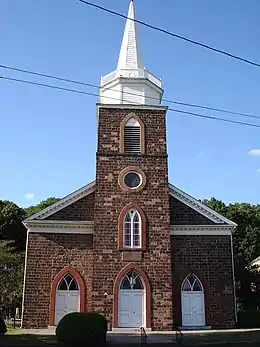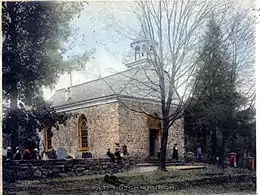
| New Netherland series |
|---|
| Exploration |
| Fortifications: |
| Settlements: |
| The Patroon System |
|
| People of New Netherland |
| Flushing Remonstrance |
 |
New Netherland (Nieuw-Nederland in Dutch) was the 17th century colonial province of the Republic of the Seven United Netherlands on the northeastern coast of North America. The claimed territory was the land from the Delmarva Peninsula to southern Cape Cod. The settled areas are now part of the Mid-Atlantic states of New York, New Jersey, and Delaware, with small outposts in Connecticut and Pennsylvania. Its capital of New Amsterdam was located at the southern tip of the island of Manhattan on the Upper New York Bay.
The region was initially explored in 1609 by Henry Hudson on an expedition for the Dutch East India Company. It was later surveyed and charted, and was given its name in 1614. The Dutch named the three main rivers of the province the Zuyd Rivier (South River, now the Delaware River), the Noort Rivier (North River, now the Hudson River), and the Versche Rivier (Fresh River, now the Connecticut River). They intended to use them to gain access to the interior, the indigenous population, and the lucrative fur trade.
International law required discovery, charting, and settlement to perfect a territorial claim. Large scale settlement was rejected in favor of a formula that was working in Asia of establishing factories (trading posts with a military presence and a small support community). This period is sometimes referred to as the Dutch Golden Age, despite on-going wars on the European continent, and it was difficult to recruit people to leave the economic boom and cultural vibrancy of Europe. Mismanagement and under-funding by the Dutch West India Company hindered early settlement, as well as misunderstandings and armed conflict with Indians. Liberalization of trade, a degree of self-rule, and the loss of Dutch Brazil led to exponential growth in the 1650s. Transfers of power from the Netherlands to England were peaceful in the province, the last one formalized in 1674.
Forts and Factorijen
The first of two Forts Nassau was built in Mahican territory during the first decade, where commerce could be conducted with Indians, and factorijen (small trading posts) went up at Schenectady, Schoharie, Esopus, Quinnipiac, Communipaw,[1] Ninigret, Totoket,[2] Schuykill, and elsewhere. Trapper Jan Rodrigues is believed to have been the first non-Indian to winter on the island of Manhattan in 1613.
Nut Island
The States General of the Dutch Republic awarded the newly formed Dutch West India Company a trade monopoly for the region in 1621, and New Netherland became a province of the Dutch Republic in 1624. The South River was initially chosen as the site of the capital because the colonists felt that it had the best climate. However, summer humidity, mosquitos, and winter freezing made the North River more appealing. A number of ships brought settlers to the New World, at first to Noten Island and soon after to the tip of Manhattan, and the colonists began construction of Fort Amsterdam, around which the colony began to grow. Small groups of the early arrivals were dispersed to Fort Orange, to Fort Wilhelmus, or to Kievets Hoek, but those who went to Fort Wilhelmus and Kievets Hoek were later recalled. Among those who made the crossing were many Walloons and 11 Africans as company-owned slaves.
Patroonships
In 1629, the Dutch West India Company introduced the Charter of Freedoms and Exemptions, a series of inducements commonly known as the patroon system. Invested members could receive vast land patents and manorial rights, somewhat reminiscent of a feudal lord, if they were willing to fulfill certain conditions, including transporting and settling at least 50 persons. A number of attempts were made, but the only notable success was the Manor of Rensselaerswyck.[3] Pavonia, across the river from New Amsterdam, was returned to the company and became a company-managed holding. In 1640, company policy was changed to allow land purchases by individuals in good standing.[1]
South River
Another patroon patent was Zwaanendael Colony later named by the British, Lewes, Delaware (the town is still known as such), the first Dutch colonial settlement on the Zuyd Rivier (Delaware Bay), but it was plundered soon after its founding in 1631.[4] After 1638, settlement was mostly in New Sweden, and these were brought under New Netherland control in 1655 when Fort Casimir was built. In 1663, Pieter Corneliszoon Plockhoy attempted to create a utopian settlement in the region, but it expired under English rule.[5]
Fresh River (Connecticut)
The Dutch established a short-lived factorij trading post at Kievits Hoek (or Plover's Corner) in present-day Old Saybrook, Connecticut, shortly after constructing their first settlement on the island of Manhattan. They abandoned it soon after, however, in order to focus on the trading post at Fort Goede Hoop on the Connecticut River, which was completed in 1633. The Dutch also had a trading post and possible fort at the mouth of the Branford River in Branford, Connecticut, which still contains a wharf called "Dutch Wharf."[6][7][8] Soon after, settlers from the Massachusetts Bay Colony formed the Connecticut Colony in 1639,[9] and the New Haven Colony soon followed. Petrus Stuyvesant attempted to prevent further competition for the area and agreed to a border 50 miles west of the river in the Treaty of Hartford (1650). This did not stem the flow of New Englanders to Long Island and the mainland along Long Island Sound, however.
North River
The port called the Manhattans grew up at the mouth of the North River (Hudson River). New Amsterdam was the capital of the province and received its municipal charter in 1652; this included the isle of Manhattan, Staaten Eylandt, Pavonia, and the Lange Eylandt towns, including Gravesend, Breuckelen, and Nieuw Amersfoort.
A municipal charter was also granted to Beverwijck in 1652, which had grown from a trading post to a bustling town in the midst of Rensselaerswyck.[10] In 1657, the homesteads scattered along the west bank of the Hudson Valley in Esopus country were required to build a garrison that became the province's third largest town of Wiltwijk.
The Dutch Belt
Colonial settlers spread throughout the region after the final transfer of power to the English with the Treaty of Westminster (1674), establishing many of the towns and cities that exist today.[11] The Dutch Reformed Church played an important role in this expansion.[12] Settlers followed the course of the Hudson River in the north via New York Harbor to the Raritan River in the south along what George Washington called the "Dutch Belt".[13]
Demographics
Population estimates do not include Native Americans.
List of settlements


.jpg.webp)



Reformed Congregations pre-1776 (selection)
- 1683 - New Pfaltz [36] (Huguenot)
- 1684 - Sleepy Hollow
- 1686 - Hackensack[37]
- 1693 - Acquackanonk[38] in Passaic
- 1694 - Tappan[39]
- 1699 - Brick in Marlboro[40]
- 1700 - Second River[41] in Belleville
- 1703 - Six Mile Run[42]
- 1710 - Ponds[43] in Oakland
- 1716 - Claverack
- 1716 - Fishkill[44]
- 1716 - Poughkeepsie[44]
- 1717 - New Brunswick[45]
- 1717 - Schaghticoke [46]
- 1719 - North Branch[47]
- 1720 - Fairfield[48]
- 1723 - Herkimer[49] (German Palatines)
- 1724 - Schraalenburgh now Dumont
- 1725 - Paramus[50]
- 1725 - Stone Arabia in Palatine (German Palatines)[51]
- 1727 - Harlingen[52]
- 1731 - Rhinebeck[53]
- 1736 - Pompton Plains[54]
- 1740 - Ramapo in Mahwah
- 1750 - Canajoharie[55]
- 1750 - Clarkstown[56]
- 1755 - Totowa [38][57] in Paterson
- 1756 - Schodack
- 1756 - Montivlle[58]
- 1758 - Caughnawaga now Fonda[59]
- 1758 - New Hackensack[60] in Town of Wappinger
- 1758 - Bedminster[61]
- 1763 - Betlehem
- 1765 - Ghent
- 1770 - English Neighborhood, now Ridgefield[62][63][64]
- 1774 - Kakiat now West New Hempstead[65][66]
- 1776 - Hillsdale[67]
See also
References
- 1 2 "The English and Dutch Towns of New Netherland". American Historical Review Vol. 6 No. 1 (Oct. 1900), pp1‑18. penelope.uchicago.edu (University of Chicago). Retrieved 2011-12-15.
- ↑ The Dutch set up a trading post at the mouth of the Branford River in the 1600s, the source of the name "Dutch Wharf." "Branford Chamber of Commerce, Branford Connecticut". Archived from the original on 2006-06-26. Retrieved 2006-06-27. Branford Chamber of Commerce
- ↑ "Freedoms, as Given by the Council of the Nineteen of the Chartered West India Company to All those who Want to Establish a Colony in New Netherland". World Digital Library. 1630. Retrieved 2013-07-28.
- ↑ The Zwaanendael Museum
- ↑ Bart Plantegna. (April 2001) "The Mystery of the Plockhoy Settlement in the Valley of Swans Archived 2010-12-21 at the Wayback Machine". Mennonite Historical Bulletin.
- ↑ http://www.branfordct.com/guide_history.htm Archived 2006-06-26 at the Library of Congress Web Archives Branford Chamber of Commerce web site accessed 26 June 2006
- ↑ "Branford Point Historic District, Branford Town, New Haven County, Branford CT, 06405".
- ↑ The Archaeology of 17th-Century New Netherland Since 1985: An Update Paul R. Huey Northeast Historical Archaeology Volume 34 From the Netherlands to New Netherland: The Archaeology of the Dutch in the Old and New Worlds Article 6 (2005) https://orb.binghamton.edu/cgi/viewcontent.cgi?referer=https://www.google.com/&httpsredir=1&article=1083&context=neha
- ↑ Suckiaug
- 1 2 "Beverwyck". Archived from the original on 2016-03-03. Retrieved 2009-01-03.
- ↑ "From Revolution to Reconstruction: Essays: The United States of America and the Netherlands: Index". Archived from the original on 2011-05-18. Retrieved 2009-03-03.
- ↑ http://www.ccel.org/s/schaff/encyc/encyc09/htm/iv.vii.c.htm Schaff, Philip; The New Schaff-Herzog Encyclopedeia of Religious Knowledge
- 1 2 3
- Lucas Litchenberg, De Nieuwe Wereld van Peter Stuyvesant: Nederlandse voetsporen in de Verenigde Staten, ISBN 90-5018-426-X, NUGI 470, Uitgeverij Balans, 1999
- ↑ Joan Blaeu, Nova Belgica et Anglia Nova
- ↑ New York: History - Islands Draw Native American, Dutch, and English Settlement
- ↑ A brief outline of Dutch history and the province of New Netherland Archived 2009-07-13 at the Wayback Machine
- ↑ Connecticut River Section - Rodenburg (New Haven)
- ↑ Bert van Steeg,Walen in de Wildernis :"Walen in de Wildernis". Archived from the original on 2008-05-17. Retrieved 2008-12-02., soon after abandoned Bij aankomst in de kolonie werden de kolonisten opgesplitst in vier groepen en werden er op een aantal plaatsen kleine vestigingen gesticht, vooral in de buurt van de al bestaande handelsposten. Een aantal families werden gevestigd aan de Delaware. Hier werd fort Wilhelmus gesticht. Twee families en zes mannen werden naar de Connecticut rivier gestuurd. Ook op Governors’ eiland werden een aantal kolonisten geplaatst om een fort te bouwen. Het grootste aantal kolonisten, onder wie Catalina Rapalje, werd echter net ten zuiden van het huidige Albany geplaatst. May liet hier een klein fort bouwen dat de naam Fort Orange kreeg. Hier verbleven ongeveer achttien families.[30]Brodhead, J.R., History of the state of New York (New York 1871 || 150-191
- ↑ http://www.rootsweb.ancestry.com/~nycoloni/nnlandex5.html
- ↑ Rabushka, Alwina Taxation in Colonial America
- ↑ Ruttenber,E.M.,Indian Tribes of Hudson's River, ISBN 0-910746-98-2 (Hope Farm Press, 3rd ed, 2001 ||
- ↑ "Communipaw". Archived from the original on 2016-06-04. Retrieved 2008-12-26.
- ↑ Hansen, Harry (1950). North of Manhattan. Hastings House. OCLC 542679., excerpted at The Bronx... Its History & Perspective
- ↑ O’Callaghan, Edmund B, Bertold Fer|| ed., Documents relative to the colonial history of the state of New York (Albany 1856-1887 || Book II, Chapter II, PartIV "The History of New York State, Book II, Chapter II, Part IV". Archived from the original on 2009-02-14. Retrieved 2008-12-26.
- ↑ Land Grants 1630-1664, N - U
- ↑ Long Island Section – Maspeth Archived 2012-06-08 at the Wayback Machine
- ↑ Maspeth, Queens County, New York
- ↑ History of Hempstead Village
- ↑ Site Of Fort Casimir Archived 2010-08-21 at the Wayback Machine
- ↑ BROOKLYN NEIGHBORHOODS.. Present & Past. Retrieved December 21, 2006.
- 1 2 Dutch Colonization
- ↑ "Archived copy". Archived from the original on 2010-08-30. Retrieved 2010-04-12.
{{cite web}}: CS1 maint: archived copy as title (link) - ↑ The Old Dutch Reformed Church
- ↑ "Rye Historical Society - Timothy Knapp House". Archived from the original on 2008-08-23. Retrieved 2008-12-27.
- ↑ Staff. "HUGUENOTS WILL STAGE STATEN ISLAND FETE; Will Celebrate Today Settlement of Old Town in 1661-- Gov. Roosevelt Invited.", The New York Times, June 28, 1931. Retrieved January 11, 2009.
- ↑ New Paltz Reformed Church – Church History
- ↑ Hackensack First Reformed
- 1 2 "New Jersey Historical Society". Archived from the original on 2016-06-24. Retrieved 2018-11-05.
- ↑ Tappan: A Walk Through History
- ↑ http://www.oldbrickchurch.org/history.html%5B%5D
- ↑ Belleville Second Reformed
- ↑ Our Historic Church – Six Mile Run Reformed Church Archived 2011-07-28 at the Wayback Machine
- ↑ Home
- 1 2 "Our History". Frishkill Reformed Church. Archived from the original on 2011-07-26. Retrieved 2011-07-27.
By 1716 they wanted their own Dutch Reformed church so they would not have to cross the river to Kingston or New Paltz to worship. In that year two congregations were established on October 10th: one in Poughkeepsie and one in Fishkill. Poughkeepsie's church building was finished in 1723
- ↑ First Reformed Church — New Brunswick, New Jersey Archived 2012-07-07 at archive.today
- ↑ Schaghticoke
- ↑ "Readington Reformed Church".
- ↑ "A Brief History of Fairfield Reformed Church". Retrieved 2011-07-27.
- ↑ Old Fort Herkimer Church, First Settlers
- ↑ "Paramus Reformed Church". New Jersey Churchscape. Retrieved 2011-07-27.
- ↑ http://www.fortklock.com/StoneArabia.htm
- ↑ Harlingen Church
- ↑ Rhinebeck Reformed Church
- ↑ Pompton Plains Reformed
- ↑ The Story of Old Fort Plain
- ↑ Dutch Reformed Church Records Clarkstown New York
- ↑ The Reformed Dutch Churches of Paterson, NJ (1930) - Passaic County Historical Society Archived 2015-12-19 at the Wayback Machine
- ↑ "Montville Reformed Church History". Archived from the original on 2009-01-25. Retrieved 2011-05-17.
- ↑ "History". Archived from the original on 2008-08-28. Retrieved 2009-01-13.
- ↑ New Hackensack Reformed Church
- ↑ Bedminster Reformed
- ↑ Ridgefield English NeighborhoodReformed
- ↑ Beck, Henry Charleton, Tales and Towns of Northern New Jersey, Rutgers University Press, ISBN 978-0-8135-1019-4
- ↑ Tales and Towns of Northern New Jersey – Google Boeken
- ↑ Marriage Records of the Reformed Dutch Church of Kakiat West New Hempstead New York 1774-1898
- ↑ "Maddie's Ancestor Search: Kakiat, Rockland Co., NY, Dutch Reformed Church Records: Part 1". 20 January 2011.
- ↑ The Reformed Dutch Church Of Hillsdale
Sources
- Dutch Reformed Church Records
- History of Dutch Reformed Church
- Colonial Maps
- Jacobs, Jaap (2005). New Netherland: A Dutch Colony In Seventeenth-Century America. BRILL. ISBN 90-04-12906-5.
- NNL chronology


